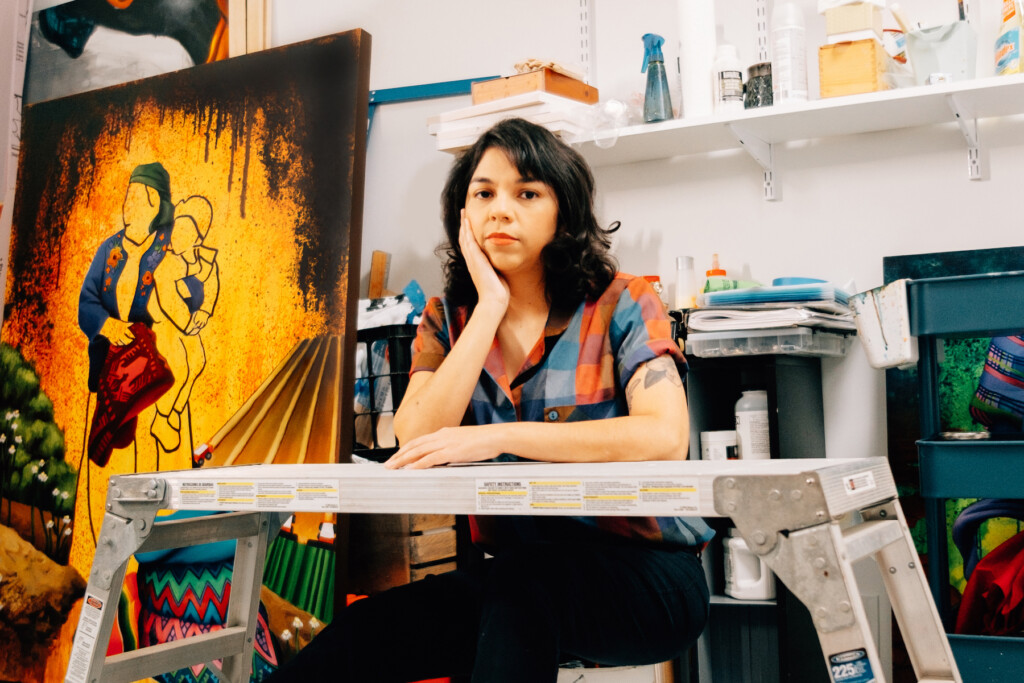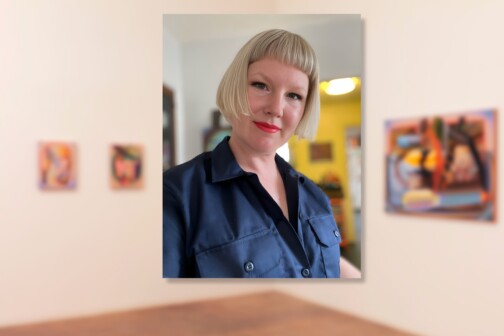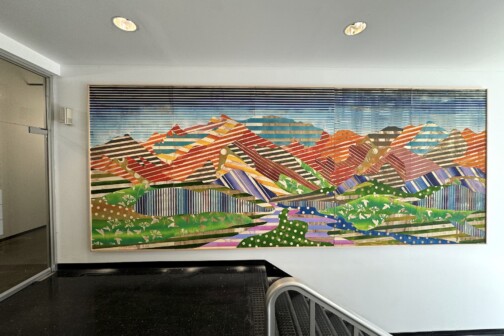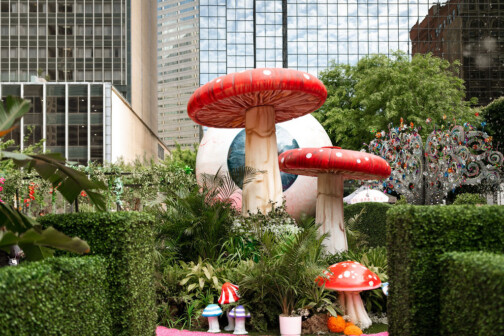Eliana Miranda reads stories from around the world, then panics.
She reads about screaming children who weigh a fraction of their ideal weights in Guatemala, hurricanes so violent they take out entire cities in Honduras, homes surrounded by such a thick smog its inhabitants must wear masks outdoors in Oregon.
She takes in what she sees around her. Climate change isn’t coming. It’s here.
And then she paints.
“I want people to look at my work and understand that this is a pressing issue, and it needs to be dealt with and we need to work together to do something about it,” Miranda said, “or else it’s just going to get worse.”
Miranda is an Oak Cliff-based art activist. Her work highlights the climate catastrophes that have displaced millions. Harsh fluorescent colors backdrop migrants outlined in uneasy lines. There are no faces. Refugees are intentionally generalized into silhouettes.
Miranda’s work is mostly centered on Central America, where natural disasters and droughts have displaced over a million people.
“This is not something that they want to do,” Miranda says. “A lot of these people don’t want to leave their land. We all have these ties and this relationship to our land, and they’re basically being forced to move for the means of survival.”
At least 1.5 million people were displaced in Central America in 2020 because of natural disasters like Hurricanes Eta and Iota, according to The International Federation of Red Cross and Red Crescent Societies. The organization estimates 937,000 people were displaced in Honduras, 339,000 in Guatemala, and 232,000 in Nicaragua.
Miranda learned about Funafuti in a 2012 New York Times article. The capital of the island nation Tuvalu, formerly known as Ellice Islands, is between Australia and Hawaii in the Pacific Ocean.
The article highlighted the rising sea levels that threatened to drown Funafuti. It spoke of the air that was pungent with the smell of garbage and human and animal waste that accumulated in borrow pits. It described the homes that stood on stilts because there was no more land on which to build.
Miranda was horrified.
“The first time I read the article, it was a moment of disbelief,” Miranda said. “It terrified me because I realized that this is a problem that will get worse and places are going to become inhabitable. It gave me a sense of urgency to address the issue.”

She began by painting environmental disasters. She continued to explore the relationship of the land and its people through journals and articles. Her work evolved with each article she read.
Her acrylic and charcoal on wood panels painted scenes blended to bring the reality of migration face-to-face with viewers. In some works, black and white figures blend into the background. A field worker sat next to corn crops ravished by droughts in her 2015 work, “Dead Crops.” Migrants clung together on a sinking boat in Miranda’s 2016 piece, “Crowded Voyages.”
In 2018 and 2019, Miranda addressed over-consumption through images of overflowing waste, collapsing infrastructure and the damaging cyclical nature of urban development
Dallas artist Tina Medina encountered Miranda’s work in 2017 at Ro2 Gallery’s “CHAOS” show. For the show, Miranda contemplated the future. “Where Are We Headed?” displays a landscape of trash in blue and green hues. Green, swollen clouds loom overhead. “Where Are We Headed? II” imagines a crumbling infrastructure in an array of yellows.
Miranda’s work lured Medina in with its jarring subject matter. It was a portal into which alarms sounded.
“I could feel someone trying to communicate to me, ‘Look, something is going on, something is important,’” Medina said. “Before you know it, you’re looking at them and oops, you’re seeing something uncomfortable.”
Miranda’s “Submerged,” a series centered on floods, was showcased in the John H. Milde Gallery at Goldmark Cultural Center in Dallas in 2021. Scenes of migrants fleeing from floods in Peru, India, and Pakistan brought viewers face-to-face with the reality of the world’s current state.
In 2022, Medina, Miranda, and artist Karla García joined forces to found Nuestra Artist Collective, a concept born over coffee and discussion about identity, culture, and heritage. The trio aimed to elevate Latina and women artists through collaboration and support.
The collective debuted their first exhibition “Fronteriza” on Oct.1 at the Oak Cliff Cultural Center. The exhibition focused on the U.S.-Mexico border.
For “Fronteriza,” Miranda’s research focused on the corredor seco, or dry corridor, that spans Costa Rica, Nicaragua, Honduras, El Salvador and Guatemala.
There, rural poverty is common and 50.5 percent of the region is classified as experiencing a high drought. Droughts followed by intense rains create food insecurity and force migration, according to the Food and Agriculture Organization of the United Nations.
She used this knowledge to create “Dejar Atrás,” an art installation Miranda considers her most impactful work.
A foam board insulation resembling a wooden border wall encloses two paintings of mothers with their children connected by a third painting of Central America’s outline. Miranda can barely stand to look at the painting on the right.
“This one is really, like, really upsetting for me to look at,” Miranda said. “In a lot of ways because it’s just the people in it.”
An indigenous mother from Guatemala stands holding her child. They wear traditional clothing. Their land is being destroyed by mass agriculture, with plows in the background. Their homes, culture, traditions, and life as they know it dry up with the land, Miranda says.
García, the other founding artist in the collective, said she is overcome with empathy when she looks at this work.
“It really makes me tear up,” García said. “These forms, these figures and these families that are crossing are very tender. We don’t know who they are and it makes me think about that exact thing. We don’t know who’s coming or who’s going, but they’re human beings.”
These issues aren’t going away, Miranda says. She says her work is a call for awakening.
Miranda’s 2023 works, “Qué Vamos Hacer?” and “Dejamos Todo?” landmark Miranda’s shift to the social repercussions of the climate crisis.
The alarming works depict the real-time Guatemalan families left behind by migrant fathers in search of economic opportunity. Starving mothers and children are plentiful. Men are nearly non-existent.
“These are actual climate migrants, these are real people from those regions,” Miranda says.
Both pieces found roots in a Sky News article. Miranda read of 24-year-old Ramunda Ramirez, a mother of four who wards off her children’s hunger with early bedtimes and water. Ramirez and her two daughters are the primary subjects of “Dejamas Todo?”
These works are on exhibition mid-April 15 at Presa House, a San Antonio art gallery, as part of Nuestra Artist Collective’s exhibition “Aquí Y Allá.”
On April 24, two days after Earth Day, Miranda will introduce Dallas to new works as part of a two-person exhibition at Umbrella Gallery. Ceramicist Daniela Maria Ferreira Cabeza-Venegas and Miranda will sound the alarms on the global climate crisis’ repercussions. The exhibition will run until May 26, with an artist reception on April 28 from 6 p.m. to 8 p.m.
“Climate change is something that’s going to affect all of us. It’s not just a nature issue. It really is a human crisis,” Miranda says.
Get the FrontRow Newsletter
Author






